Organisational Behaviour Report: Sainsbury's, Factors & Theories
VerifiedAdded on 2023/01/04
|18
|6216
|24
Report
AI Summary
This report provides a detailed analysis of organisational behaviour within Sainsbury's, a major UK retail supermarket. It examines how culture, power dynamics, and organizational policies influence individual and team behaviour. The report explores various cultural models, including Handy's Culture Model and Hofstede's dimensions, to understand their impact on employee behaviour and organizational effectiveness. It also delves into the role of politics and power structures within the organization. Furthermore, the report discusses content and process theories of motivation, such as Maslow's hierarchy of needs, to understand how to motivate employees effectively. It also analyses the factors that contribute to effective and ineffective teams, and the concepts and philosophies of organisational behaviour in the context of Sainsbury's. The report concludes with a summary of the key findings and implications for organizational management.
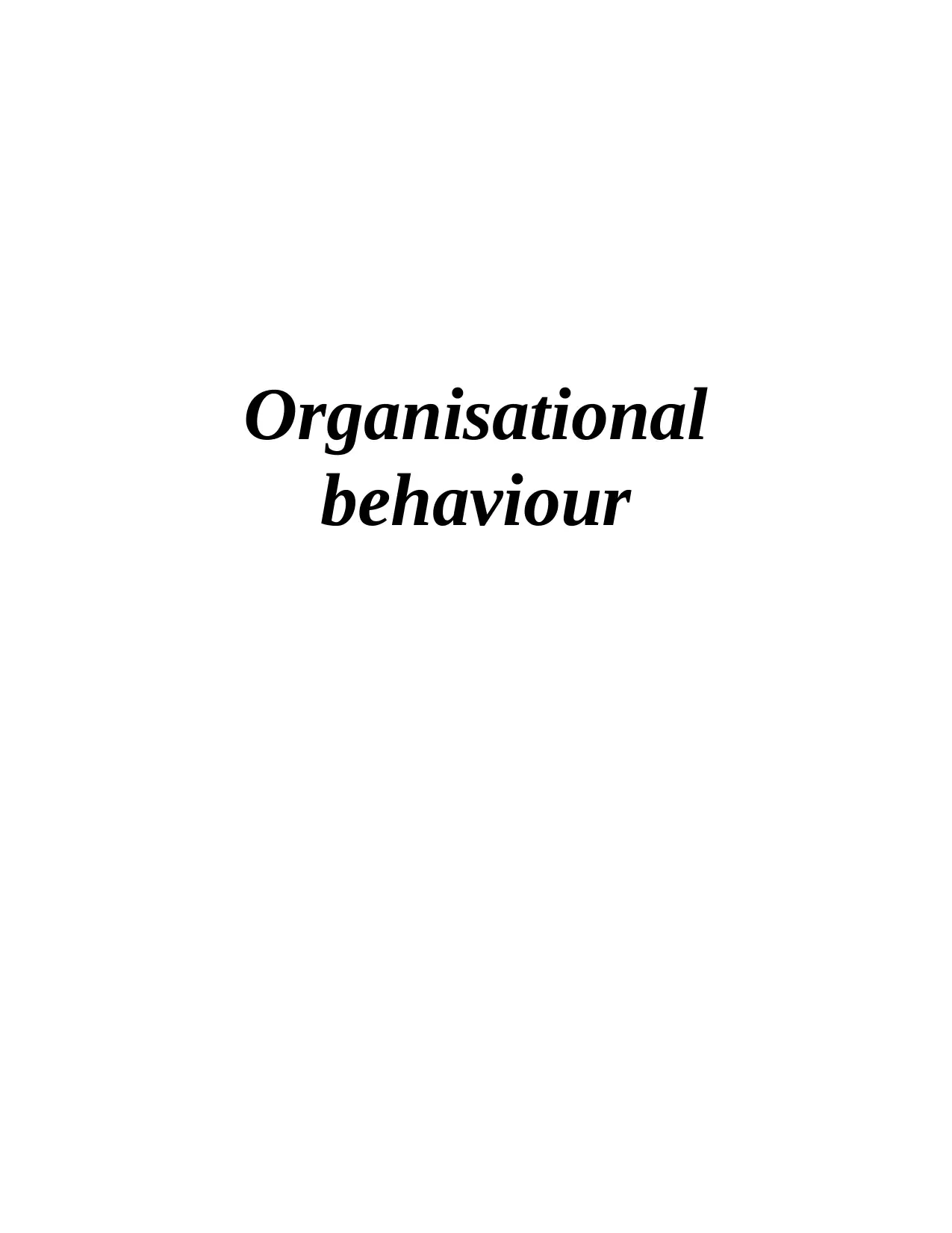
Organisational
behaviour
behaviour
Paraphrase This Document
Need a fresh take? Get an instant paraphrase of this document with our AI Paraphraser
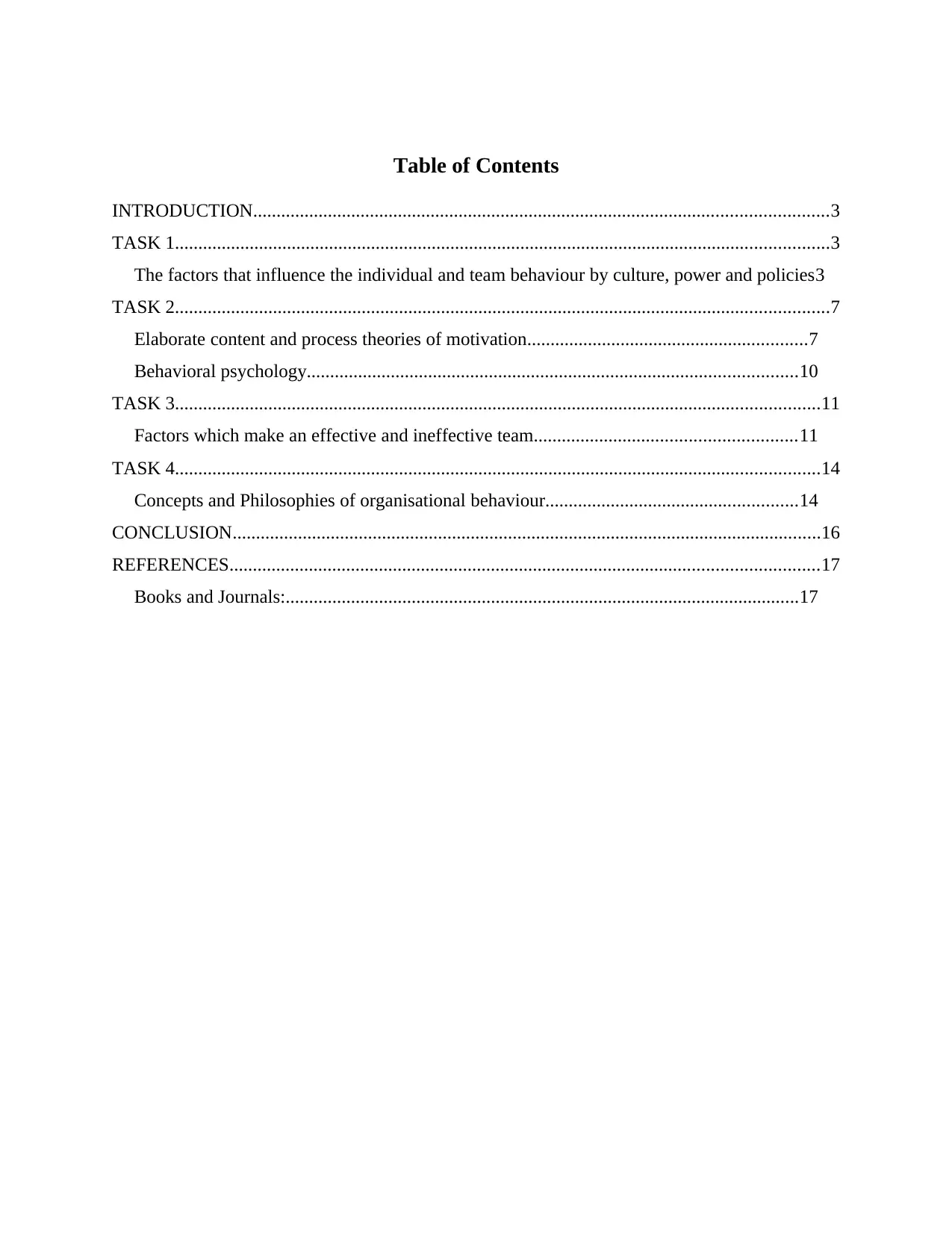
Table of Contents
INTRODUCTION...........................................................................................................................3
TASK 1............................................................................................................................................3
The factors that influence the individual and team behaviour by culture, power and policies3
TASK 2............................................................................................................................................7
Elaborate content and process theories of motivation............................................................7
Behavioral psychology.........................................................................................................10
TASK 3..........................................................................................................................................11
Factors which make an effective and ineffective team........................................................11
TASK 4..........................................................................................................................................14
Concepts and Philosophies of organisational behaviour......................................................14
CONCLUSION..............................................................................................................................16
REFERENCES..............................................................................................................................17
Books and Journals:..............................................................................................................17
INTRODUCTION...........................................................................................................................3
TASK 1............................................................................................................................................3
The factors that influence the individual and team behaviour by culture, power and policies3
TASK 2............................................................................................................................................7
Elaborate content and process theories of motivation............................................................7
Behavioral psychology.........................................................................................................10
TASK 3..........................................................................................................................................11
Factors which make an effective and ineffective team........................................................11
TASK 4..........................................................................................................................................14
Concepts and Philosophies of organisational behaviour......................................................14
CONCLUSION..............................................................................................................................16
REFERENCES..............................................................................................................................17
Books and Journals:..............................................................................................................17

INTRODUCTION
An organisation is a group of individual who work together in order to achieve common
goal prospective. For which organisation have to analyse its behaviour through focusing on
working environment, human resource interaction, team work, also employee’s proficiency at
work. In other words, organisational behaviour promotes planning policies, organising business
activities, also ensuring proper guidance and controlling in order to eliminate unnecessary work
(Abdullah and Marican, 2020). In order to understand this behaviour, this report is based on the
organisation SAINSBURY'S. It is a second largest retail supermarket store in United Kingdom,
founded in 1869, retailing in products like groceries, consumer good, convenience goods and
many more [online]. It covers wide area with 1428 shops all over in London and has a rivalry
competition with Asda and Tesco. With the view to this organisation, this report covers the
factors which influence on organisational environment, also various leadership style and
philosophies to make an organisation effective and efficient.
TASK 1
The factors that influence the individual and team behaviour by culture, power and policies
Environment of an organisation is depended and influenced by its nature, internal and
external factors which puts the enterprise into one long term goal contribution, these factors
creates some rules and regulations to work accordance with the set culture, political influence,
and individual powers and authority. The entitled manager of Sainsbury should consider the
below mentioned factors and forces in order to assess the degree of performance of the various
employees sop as to achieve and accomplish the long and short term objectives of respective
organisation.
Culture: An organisational activities and performance is bound by its culture which
creates some norms and a value regarding behaviour, beliefs and organisational perceptions
which is set by leaders and managers in order to promotes valuable functioning within
organisation (Christy and Duraisamy, 2016). Sainsbury's is the large organisation so it is very
obvious that get affected by culture or environment of the organisation. Also, culture defines
understandings and business criteria amongst employees by setting strategies and conditions
regarding work done.
Types of culture and its influence on employee’s behaviour
An organisation is a group of individual who work together in order to achieve common
goal prospective. For which organisation have to analyse its behaviour through focusing on
working environment, human resource interaction, team work, also employee’s proficiency at
work. In other words, organisational behaviour promotes planning policies, organising business
activities, also ensuring proper guidance and controlling in order to eliminate unnecessary work
(Abdullah and Marican, 2020). In order to understand this behaviour, this report is based on the
organisation SAINSBURY'S. It is a second largest retail supermarket store in United Kingdom,
founded in 1869, retailing in products like groceries, consumer good, convenience goods and
many more [online]. It covers wide area with 1428 shops all over in London and has a rivalry
competition with Asda and Tesco. With the view to this organisation, this report covers the
factors which influence on organisational environment, also various leadership style and
philosophies to make an organisation effective and efficient.
TASK 1
The factors that influence the individual and team behaviour by culture, power and policies
Environment of an organisation is depended and influenced by its nature, internal and
external factors which puts the enterprise into one long term goal contribution, these factors
creates some rules and regulations to work accordance with the set culture, political influence,
and individual powers and authority. The entitled manager of Sainsbury should consider the
below mentioned factors and forces in order to assess the degree of performance of the various
employees sop as to achieve and accomplish the long and short term objectives of respective
organisation.
Culture: An organisational activities and performance is bound by its culture which
creates some norms and a value regarding behaviour, beliefs and organisational perceptions
which is set by leaders and managers in order to promotes valuable functioning within
organisation (Christy and Duraisamy, 2016). Sainsbury's is the large organisation so it is very
obvious that get affected by culture or environment of the organisation. Also, culture defines
understandings and business criteria amongst employees by setting strategies and conditions
regarding work done.
Types of culture and its influence on employee’s behaviour
⊘ This is a preview!⊘
Do you want full access?
Subscribe today to unlock all pages.

Trusted by 1+ million students worldwide
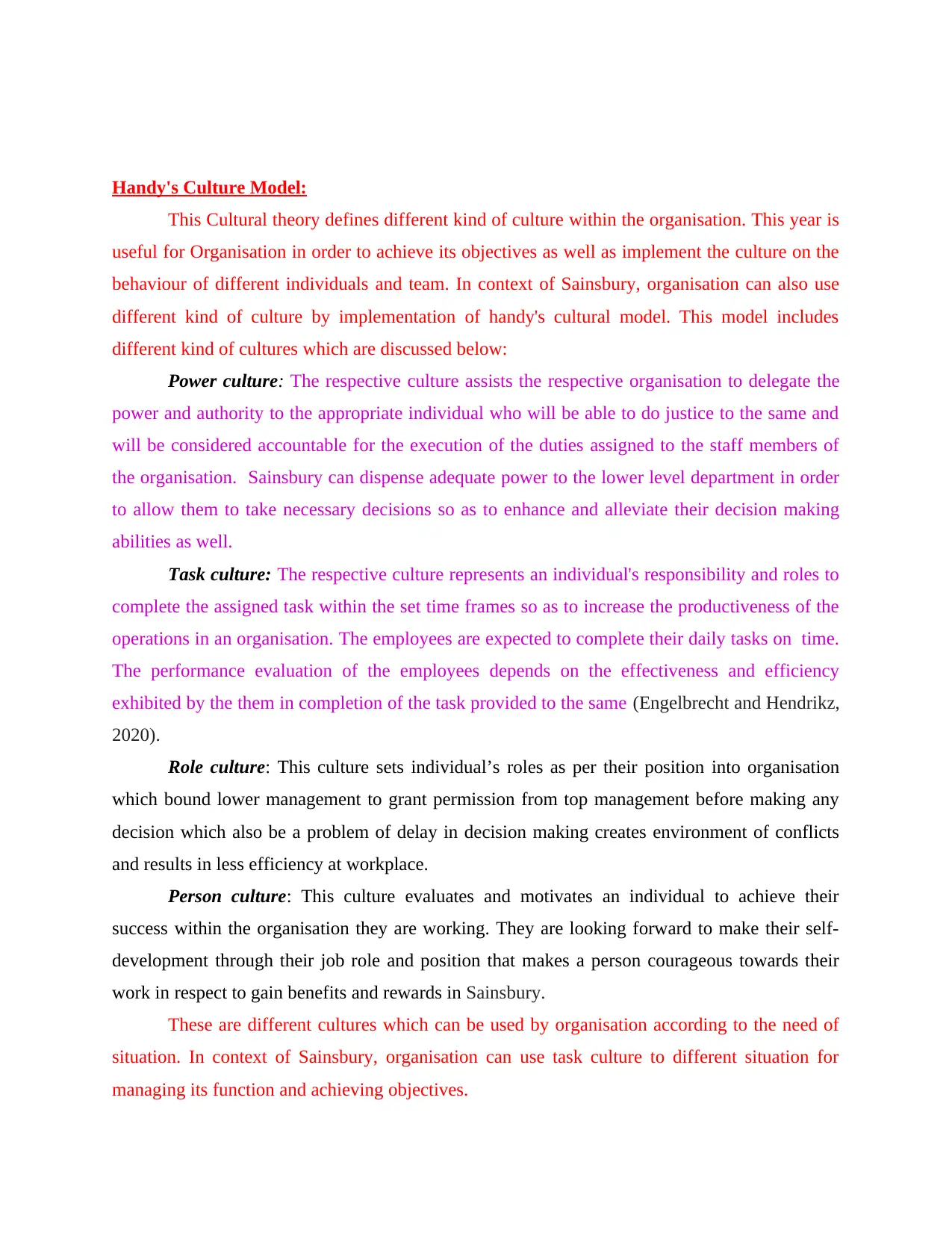
Handy's Culture Model:
This Cultural theory defines different kind of culture within the organisation. This year is
useful for Organisation in order to achieve its objectives as well as implement the culture on the
behaviour of different individuals and team. In context of Sainsbury, organisation can also use
different kind of culture by implementation of handy's cultural model. This model includes
different kind of cultures which are discussed below:
Power culture: The respective culture assists the respective organisation to delegate the
power and authority to the appropriate individual who will be able to do justice to the same and
will be considered accountable for the execution of the duties assigned to the staff members of
the organisation. Sainsbury can dispense adequate power to the lower level department in order
to allow them to take necessary decisions so as to enhance and alleviate their decision making
abilities as well.
Task culture: The respective culture represents an individual's responsibility and roles to
complete the assigned task within the set time frames so as to increase the productiveness of the
operations in an organisation. The employees are expected to complete their daily tasks on time.
The performance evaluation of the employees depends on the effectiveness and efficiency
exhibited by the them in completion of the task provided to the same (Engelbrecht and Hendrikz,
2020).
Role culture: This culture sets individual’s roles as per their position into organisation
which bound lower management to grant permission from top management before making any
decision which also be a problem of delay in decision making creates environment of conflicts
and results in less efficiency at workplace.
Person culture: This culture evaluates and motivates an individual to achieve their
success within the organisation they are working. They are looking forward to make their self-
development through their job role and position that makes a person courageous towards their
work in respect to gain benefits and rewards in Sainsbury.
These are different cultures which can be used by organisation according to the need of
situation. In context of Sainsbury, organisation can use task culture to different situation for
managing its function and achieving objectives.
This Cultural theory defines different kind of culture within the organisation. This year is
useful for Organisation in order to achieve its objectives as well as implement the culture on the
behaviour of different individuals and team. In context of Sainsbury, organisation can also use
different kind of culture by implementation of handy's cultural model. This model includes
different kind of cultures which are discussed below:
Power culture: The respective culture assists the respective organisation to delegate the
power and authority to the appropriate individual who will be able to do justice to the same and
will be considered accountable for the execution of the duties assigned to the staff members of
the organisation. Sainsbury can dispense adequate power to the lower level department in order
to allow them to take necessary decisions so as to enhance and alleviate their decision making
abilities as well.
Task culture: The respective culture represents an individual's responsibility and roles to
complete the assigned task within the set time frames so as to increase the productiveness of the
operations in an organisation. The employees are expected to complete their daily tasks on time.
The performance evaluation of the employees depends on the effectiveness and efficiency
exhibited by the them in completion of the task provided to the same (Engelbrecht and Hendrikz,
2020).
Role culture: This culture sets individual’s roles as per their position into organisation
which bound lower management to grant permission from top management before making any
decision which also be a problem of delay in decision making creates environment of conflicts
and results in less efficiency at workplace.
Person culture: This culture evaluates and motivates an individual to achieve their
success within the organisation they are working. They are looking forward to make their self-
development through their job role and position that makes a person courageous towards their
work in respect to gain benefits and rewards in Sainsbury.
These are different cultures which can be used by organisation according to the need of
situation. In context of Sainsbury, organisation can use task culture to different situation for
managing its function and achieving objectives.
Paraphrase This Document
Need a fresh take? Get an instant paraphrase of this document with our AI Paraphraser
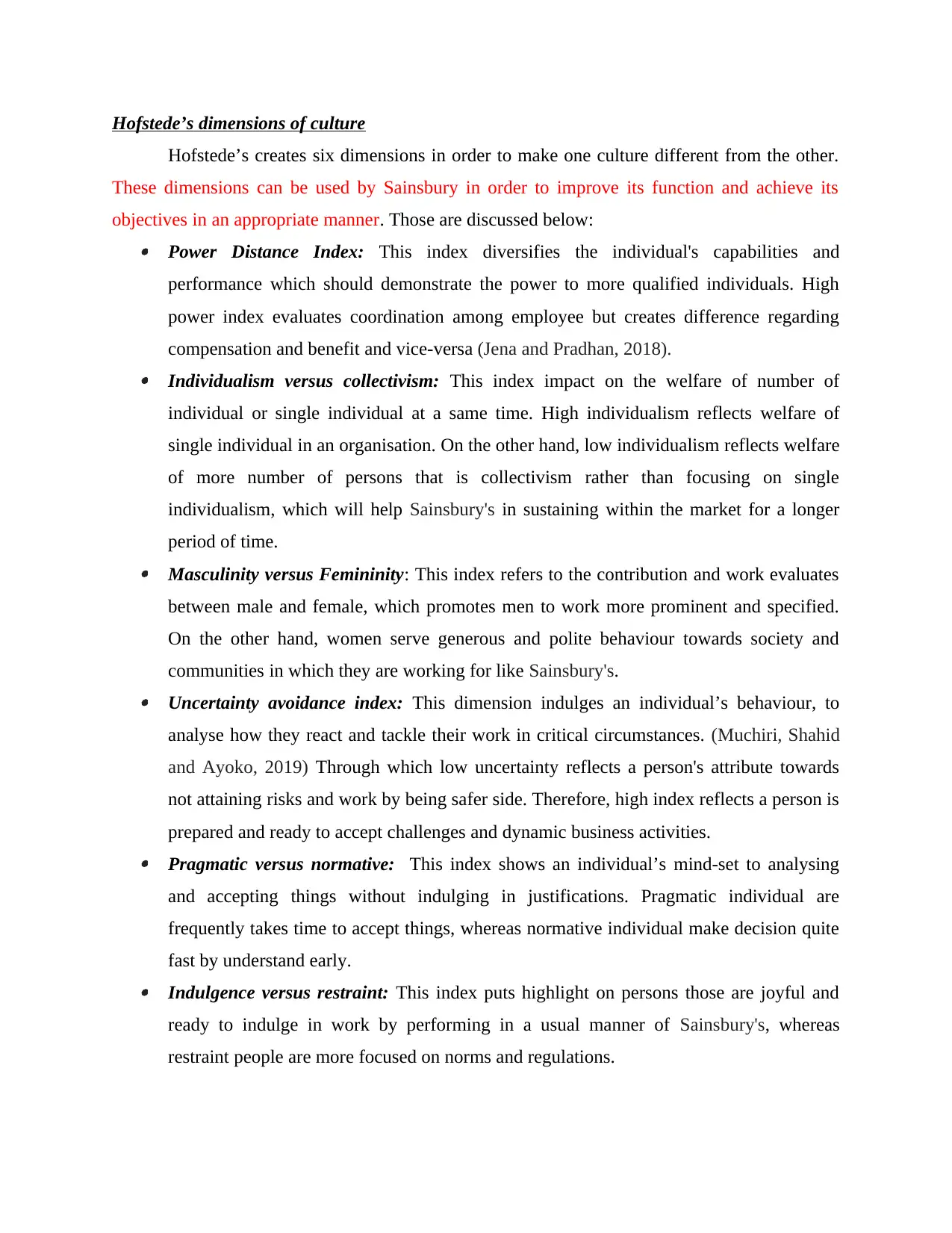
Hofstede’s dimensions of culture
Hofstede’s creates six dimensions in order to make one culture different from the other.
These dimensions can be used by Sainsbury in order to improve its function and achieve its
objectives in an appropriate manner. Those are discussed below: Power Distance Index: This index diversifies the individual's capabilities and
performance which should demonstrate the power to more qualified individuals. High
power index evaluates coordination among employee but creates difference regarding
compensation and benefit and vice-versa (Jena and Pradhan, 2018). Individualism versus collectivism: This index impact on the welfare of number of
individual or single individual at a same time. High individualism reflects welfare of
single individual in an organisation. On the other hand, low individualism reflects welfare
of more number of persons that is collectivism rather than focusing on single
individualism, which will help Sainsbury's in sustaining within the market for a longer
period of time. Masculinity versus Femininity: This index refers to the contribution and work evaluates
between male and female, which promotes men to work more prominent and specified.
On the other hand, women serve generous and polite behaviour towards society and
communities in which they are working for like Sainsbury's. Uncertainty avoidance index: This dimension indulges an individual’s behaviour, to
analyse how they react and tackle their work in critical circumstances. (Muchiri, Shahid
and Ayoko, 2019) Through which low uncertainty reflects a person's attribute towards
not attaining risks and work by being safer side. Therefore, high index reflects a person is
prepared and ready to accept challenges and dynamic business activities. Pragmatic versus normative: This index shows an individual’s mind-set to analysing
and accepting things without indulging in justifications. Pragmatic individual are
frequently takes time to accept things, whereas normative individual make decision quite
fast by understand early. Indulgence versus restraint: This index puts highlight on persons those are joyful and
ready to indulge in work by performing in a usual manner of Sainsbury's, whereas
restraint people are more focused on norms and regulations.
Hofstede’s creates six dimensions in order to make one culture different from the other.
These dimensions can be used by Sainsbury in order to improve its function and achieve its
objectives in an appropriate manner. Those are discussed below: Power Distance Index: This index diversifies the individual's capabilities and
performance which should demonstrate the power to more qualified individuals. High
power index evaluates coordination among employee but creates difference regarding
compensation and benefit and vice-versa (Jena and Pradhan, 2018). Individualism versus collectivism: This index impact on the welfare of number of
individual or single individual at a same time. High individualism reflects welfare of
single individual in an organisation. On the other hand, low individualism reflects welfare
of more number of persons that is collectivism rather than focusing on single
individualism, which will help Sainsbury's in sustaining within the market for a longer
period of time. Masculinity versus Femininity: This index refers to the contribution and work evaluates
between male and female, which promotes men to work more prominent and specified.
On the other hand, women serve generous and polite behaviour towards society and
communities in which they are working for like Sainsbury's. Uncertainty avoidance index: This dimension indulges an individual’s behaviour, to
analyse how they react and tackle their work in critical circumstances. (Muchiri, Shahid
and Ayoko, 2019) Through which low uncertainty reflects a person's attribute towards
not attaining risks and work by being safer side. Therefore, high index reflects a person is
prepared and ready to accept challenges and dynamic business activities. Pragmatic versus normative: This index shows an individual’s mind-set to analysing
and accepting things without indulging in justifications. Pragmatic individual are
frequently takes time to accept things, whereas normative individual make decision quite
fast by understand early. Indulgence versus restraint: This index puts highlight on persons those are joyful and
ready to indulge in work by performing in a usual manner of Sainsbury's, whereas
restraint people are more focused on norms and regulations.

Politics: The term politics is well defined as interference and indulgence in others matter.
Here, with an organisation politics creates an environment of inter-personal behaviour but in
negative aspects through which it creates impact on employee’s morale and efficiency of
Sainsbury's could make their demand high relative to others comparison (Narzary and Palo,
2020). In context of Sainsbury, it is identified from the research that politics is directly related to
organisational functioning. If organisation follows negative politics within the form then it can
lead to decrease the productivity as well as impact on employee relations. This is because it is
observed from the working of Sainsbury that the person who plays politics within the
organisation will focus less attention on their work and it lead to decrease in overall productivity.
In context of Sainsbury, the manager within the organisation try to reduce the impact of politics
and only use this process for motivating the employees to boost their productivity by influencing
their working behaviour. This is why organisation uses the wood politics in order to improve its
function and promote motivation within employees.
Power: Power is the capability of an individual which make them aware about proper
utilisation of it in order to perform and assign task to other workforce through proper guidance
and technique. Use of power should be in right hands so that no employee of Sainsbury's has to
suffer any discrimination or unacceptable conduct. These powers works as a motivation for
employees by following ways: Reward power: This power assures a manager or leaders to pay attention on each
employee’s performance and make them feel superior and motivated by distributing
rewards which also make their efforts double in favour of Sainsbury's benefit. Coercive power: This power influence on any miss conduct or unfeasible activities in
organisation which makes managers to provide solutions and rules regarding the
victims .and creates better prominent environment so that no body going to face any
trouble while contributing their efforts (Naz, Nisar and Rafiq, 2019).
Legitimate power: This power makes every employee well known about each one's
authority and responsibilities in Sainsbury are which is acceptable by the entire
workforce without making any interruptions and follow commands and orders.
In context of Sainsbury, it is a global organisation where the manager within the firm has to
use the powers in an appropriate manner. This is why organisation uses appropriate flow of
powers so that it can achieve the objectives and perform the function in an appropriate manner.
Here, with an organisation politics creates an environment of inter-personal behaviour but in
negative aspects through which it creates impact on employee’s morale and efficiency of
Sainsbury's could make their demand high relative to others comparison (Narzary and Palo,
2020). In context of Sainsbury, it is identified from the research that politics is directly related to
organisational functioning. If organisation follows negative politics within the form then it can
lead to decrease the productivity as well as impact on employee relations. This is because it is
observed from the working of Sainsbury that the person who plays politics within the
organisation will focus less attention on their work and it lead to decrease in overall productivity.
In context of Sainsbury, the manager within the organisation try to reduce the impact of politics
and only use this process for motivating the employees to boost their productivity by influencing
their working behaviour. This is why organisation uses the wood politics in order to improve its
function and promote motivation within employees.
Power: Power is the capability of an individual which make them aware about proper
utilisation of it in order to perform and assign task to other workforce through proper guidance
and technique. Use of power should be in right hands so that no employee of Sainsbury's has to
suffer any discrimination or unacceptable conduct. These powers works as a motivation for
employees by following ways: Reward power: This power assures a manager or leaders to pay attention on each
employee’s performance and make them feel superior and motivated by distributing
rewards which also make their efforts double in favour of Sainsbury's benefit. Coercive power: This power influence on any miss conduct or unfeasible activities in
organisation which makes managers to provide solutions and rules regarding the
victims .and creates better prominent environment so that no body going to face any
trouble while contributing their efforts (Naz, Nisar and Rafiq, 2019).
Legitimate power: This power makes every employee well known about each one's
authority and responsibilities in Sainsbury are which is acceptable by the entire
workforce without making any interruptions and follow commands and orders.
In context of Sainsbury, it is a global organisation where the manager within the firm has to
use the powers in an appropriate manner. This is why organisation uses appropriate flow of
powers so that it can achieve the objectives and perform the function in an appropriate manner.
⊘ This is a preview!⊘
Do you want full access?
Subscribe today to unlock all pages.

Trusted by 1+ million students worldwide
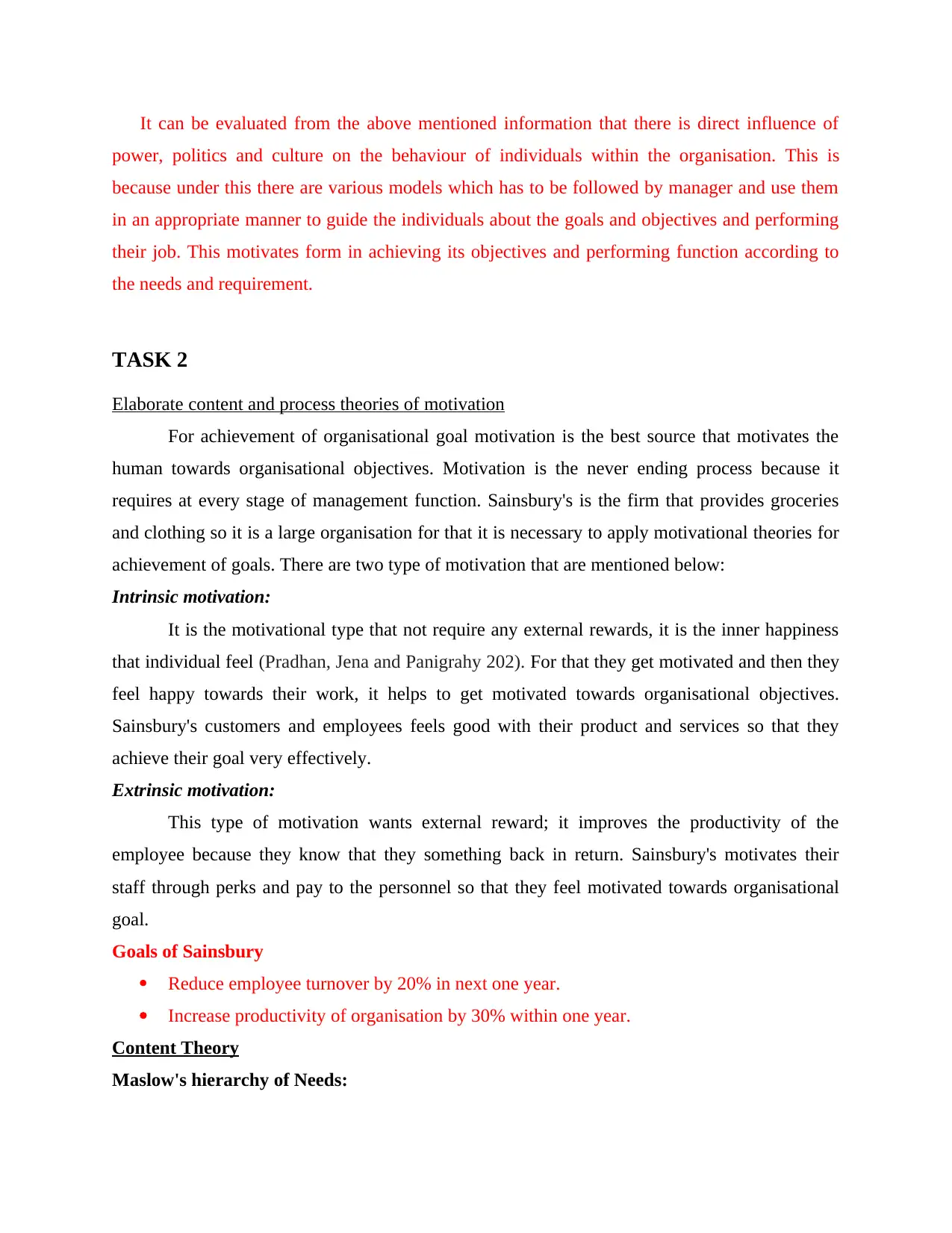
It can be evaluated from the above mentioned information that there is direct influence of
power, politics and culture on the behaviour of individuals within the organisation. This is
because under this there are various models which has to be followed by manager and use them
in an appropriate manner to guide the individuals about the goals and objectives and performing
their job. This motivates form in achieving its objectives and performing function according to
the needs and requirement.
TASK 2
Elaborate content and process theories of motivation
For achievement of organisational goal motivation is the best source that motivates the
human towards organisational objectives. Motivation is the never ending process because it
requires at every stage of management function. Sainsbury's is the firm that provides groceries
and clothing so it is a large organisation for that it is necessary to apply motivational theories for
achievement of goals. There are two type of motivation that are mentioned below:
Intrinsic motivation:
It is the motivational type that not require any external rewards, it is the inner happiness
that individual feel (Pradhan, Jena and Panigrahy 202). For that they get motivated and then they
feel happy towards their work, it helps to get motivated towards organisational objectives.
Sainsbury's customers and employees feels good with their product and services so that they
achieve their goal very effectively.
Extrinsic motivation:
This type of motivation wants external reward; it improves the productivity of the
employee because they know that they something back in return. Sainsbury's motivates their
staff through perks and pay to the personnel so that they feel motivated towards organisational
goal.
Goals of Sainsbury
Reduce employee turnover by 20% in next one year.
Increase productivity of organisation by 30% within one year.
Content Theory
Maslow's hierarchy of Needs:
power, politics and culture on the behaviour of individuals within the organisation. This is
because under this there are various models which has to be followed by manager and use them
in an appropriate manner to guide the individuals about the goals and objectives and performing
their job. This motivates form in achieving its objectives and performing function according to
the needs and requirement.
TASK 2
Elaborate content and process theories of motivation
For achievement of organisational goal motivation is the best source that motivates the
human towards organisational objectives. Motivation is the never ending process because it
requires at every stage of management function. Sainsbury's is the firm that provides groceries
and clothing so it is a large organisation for that it is necessary to apply motivational theories for
achievement of goals. There are two type of motivation that are mentioned below:
Intrinsic motivation:
It is the motivational type that not require any external rewards, it is the inner happiness
that individual feel (Pradhan, Jena and Panigrahy 202). For that they get motivated and then they
feel happy towards their work, it helps to get motivated towards organisational objectives.
Sainsbury's customers and employees feels good with their product and services so that they
achieve their goal very effectively.
Extrinsic motivation:
This type of motivation wants external reward; it improves the productivity of the
employee because they know that they something back in return. Sainsbury's motivates their
staff through perks and pay to the personnel so that they feel motivated towards organisational
goal.
Goals of Sainsbury
Reduce employee turnover by 20% in next one year.
Increase productivity of organisation by 30% within one year.
Content Theory
Maslow's hierarchy of Needs:
Paraphrase This Document
Need a fresh take? Get an instant paraphrase of this document with our AI Paraphraser
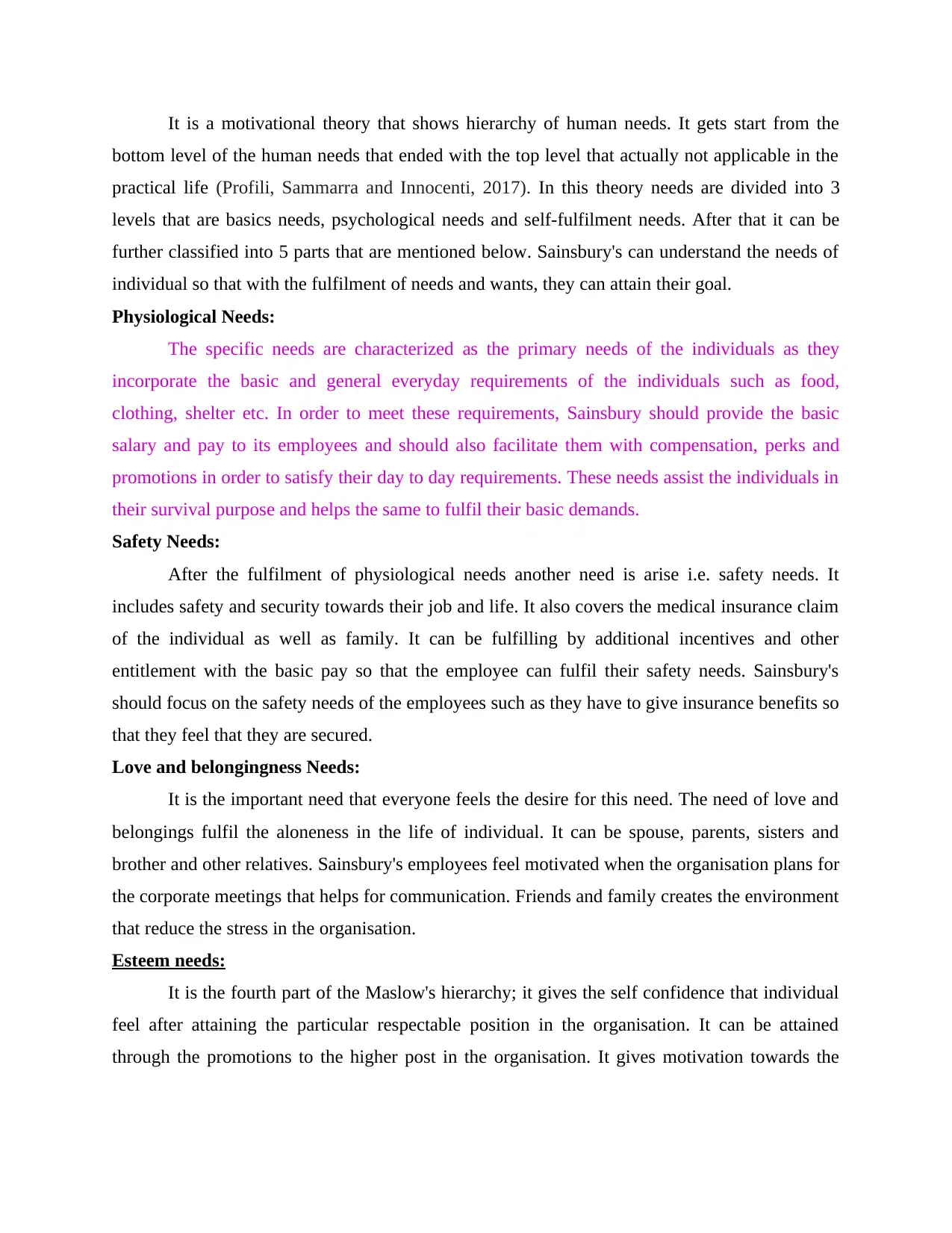
It is a motivational theory that shows hierarchy of human needs. It gets start from the
bottom level of the human needs that ended with the top level that actually not applicable in the
practical life (Profili, Sammarra and Innocenti, 2017). In this theory needs are divided into 3
levels that are basics needs, psychological needs and self-fulfilment needs. After that it can be
further classified into 5 parts that are mentioned below. Sainsbury's can understand the needs of
individual so that with the fulfilment of needs and wants, they can attain their goal.
Physiological Needs:
The specific needs are characterized as the primary needs of the individuals as they
incorporate the basic and general everyday requirements of the individuals such as food,
clothing, shelter etc. In order to meet these requirements, Sainsbury should provide the basic
salary and pay to its employees and should also facilitate them with compensation, perks and
promotions in order to satisfy their day to day requirements. These needs assist the individuals in
their survival purpose and helps the same to fulfil their basic demands.
Safety Needs:
After the fulfilment of physiological needs another need is arise i.e. safety needs. It
includes safety and security towards their job and life. It also covers the medical insurance claim
of the individual as well as family. It can be fulfilling by additional incentives and other
entitlement with the basic pay so that the employee can fulfil their safety needs. Sainsbury's
should focus on the safety needs of the employees such as they have to give insurance benefits so
that they feel that they are secured.
Love and belongingness Needs:
It is the important need that everyone feels the desire for this need. The need of love and
belongings fulfil the aloneness in the life of individual. It can be spouse, parents, sisters and
brother and other relatives. Sainsbury's employees feel motivated when the organisation plans for
the corporate meetings that helps for communication. Friends and family creates the environment
that reduce the stress in the organisation.
Esteem needs:
It is the fourth part of the Maslow's hierarchy; it gives the self confidence that individual
feel after attaining the particular respectable position in the organisation. It can be attained
through the promotions to the higher post in the organisation. It gives motivation towards the
bottom level of the human needs that ended with the top level that actually not applicable in the
practical life (Profili, Sammarra and Innocenti, 2017). In this theory needs are divided into 3
levels that are basics needs, psychological needs and self-fulfilment needs. After that it can be
further classified into 5 parts that are mentioned below. Sainsbury's can understand the needs of
individual so that with the fulfilment of needs and wants, they can attain their goal.
Physiological Needs:
The specific needs are characterized as the primary needs of the individuals as they
incorporate the basic and general everyday requirements of the individuals such as food,
clothing, shelter etc. In order to meet these requirements, Sainsbury should provide the basic
salary and pay to its employees and should also facilitate them with compensation, perks and
promotions in order to satisfy their day to day requirements. These needs assist the individuals in
their survival purpose and helps the same to fulfil their basic demands.
Safety Needs:
After the fulfilment of physiological needs another need is arise i.e. safety needs. It
includes safety and security towards their job and life. It also covers the medical insurance claim
of the individual as well as family. It can be fulfilling by additional incentives and other
entitlement with the basic pay so that the employee can fulfil their safety needs. Sainsbury's
should focus on the safety needs of the employees such as they have to give insurance benefits so
that they feel that they are secured.
Love and belongingness Needs:
It is the important need that everyone feels the desire for this need. The need of love and
belongings fulfil the aloneness in the life of individual. It can be spouse, parents, sisters and
brother and other relatives. Sainsbury's employees feel motivated when the organisation plans for
the corporate meetings that helps for communication. Friends and family creates the environment
that reduce the stress in the organisation.
Esteem needs:
It is the fourth part of the Maslow's hierarchy; it gives the self confidence that individual
feel after attaining the particular respectable position in the organisation. It can be attained
through the promotions to the higher post in the organisation. It gives motivation towards the
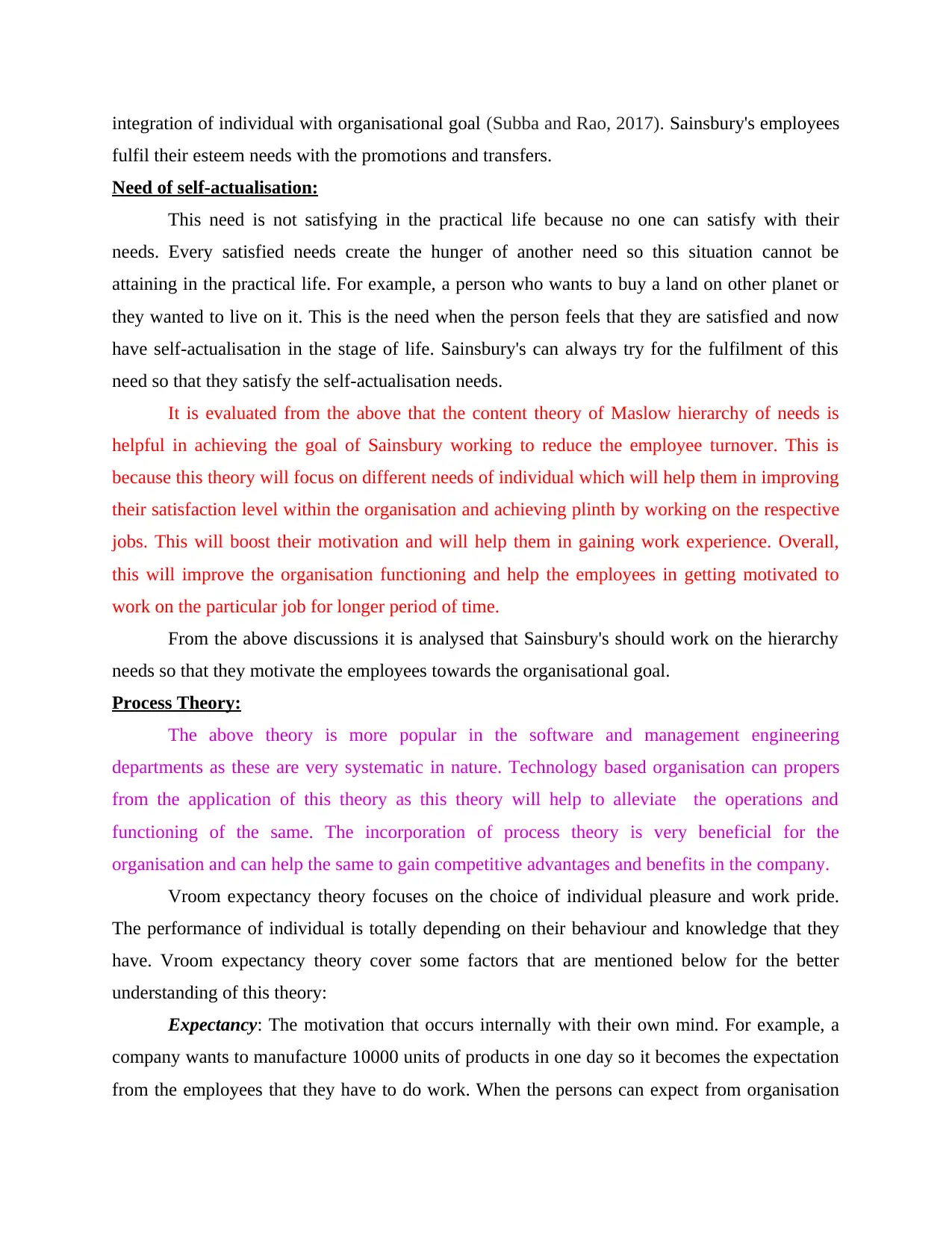
integration of individual with organisational goal (Subba and Rao, 2017). Sainsbury's employees
fulfil their esteem needs with the promotions and transfers.
Need of self-actualisation:
This need is not satisfying in the practical life because no one can satisfy with their
needs. Every satisfied needs create the hunger of another need so this situation cannot be
attaining in the practical life. For example, a person who wants to buy a land on other planet or
they wanted to live on it. This is the need when the person feels that they are satisfied and now
have self-actualisation in the stage of life. Sainsbury's can always try for the fulfilment of this
need so that they satisfy the self-actualisation needs.
It is evaluated from the above that the content theory of Maslow hierarchy of needs is
helpful in achieving the goal of Sainsbury working to reduce the employee turnover. This is
because this theory will focus on different needs of individual which will help them in improving
their satisfaction level within the organisation and achieving plinth by working on the respective
jobs. This will boost their motivation and will help them in gaining work experience. Overall,
this will improve the organisation functioning and help the employees in getting motivated to
work on the particular job for longer period of time.
From the above discussions it is analysed that Sainsbury's should work on the hierarchy
needs so that they motivate the employees towards the organisational goal.
Process Theory:
The above theory is more popular in the software and management engineering
departments as these are very systematic in nature. Technology based organisation can propers
from the application of this theory as this theory will help to alleviate the operations and
functioning of the same. The incorporation of process theory is very beneficial for the
organisation and can help the same to gain competitive advantages and benefits in the company.
Vroom expectancy theory focuses on the choice of individual pleasure and work pride.
The performance of individual is totally depending on their behaviour and knowledge that they
have. Vroom expectancy theory cover some factors that are mentioned below for the better
understanding of this theory:
Expectancy: The motivation that occurs internally with their own mind. For example, a
company wants to manufacture 10000 units of products in one day so it becomes the expectation
from the employees that they have to do work. When the persons can expect from organisation
fulfil their esteem needs with the promotions and transfers.
Need of self-actualisation:
This need is not satisfying in the practical life because no one can satisfy with their
needs. Every satisfied needs create the hunger of another need so this situation cannot be
attaining in the practical life. For example, a person who wants to buy a land on other planet or
they wanted to live on it. This is the need when the person feels that they are satisfied and now
have self-actualisation in the stage of life. Sainsbury's can always try for the fulfilment of this
need so that they satisfy the self-actualisation needs.
It is evaluated from the above that the content theory of Maslow hierarchy of needs is
helpful in achieving the goal of Sainsbury working to reduce the employee turnover. This is
because this theory will focus on different needs of individual which will help them in improving
their satisfaction level within the organisation and achieving plinth by working on the respective
jobs. This will boost their motivation and will help them in gaining work experience. Overall,
this will improve the organisation functioning and help the employees in getting motivated to
work on the particular job for longer period of time.
From the above discussions it is analysed that Sainsbury's should work on the hierarchy
needs so that they motivate the employees towards the organisational goal.
Process Theory:
The above theory is more popular in the software and management engineering
departments as these are very systematic in nature. Technology based organisation can propers
from the application of this theory as this theory will help to alleviate the operations and
functioning of the same. The incorporation of process theory is very beneficial for the
organisation and can help the same to gain competitive advantages and benefits in the company.
Vroom expectancy theory focuses on the choice of individual pleasure and work pride.
The performance of individual is totally depending on their behaviour and knowledge that they
have. Vroom expectancy theory cover some factors that are mentioned below for the better
understanding of this theory:
Expectancy: The motivation that occurs internally with their own mind. For example, a
company wants to manufacture 10000 units of products in one day so it becomes the expectation
from the employees that they have to do work. When the persons can expect from organisation
⊘ This is a preview!⊘
Do you want full access?
Subscribe today to unlock all pages.

Trusted by 1+ million students worldwide
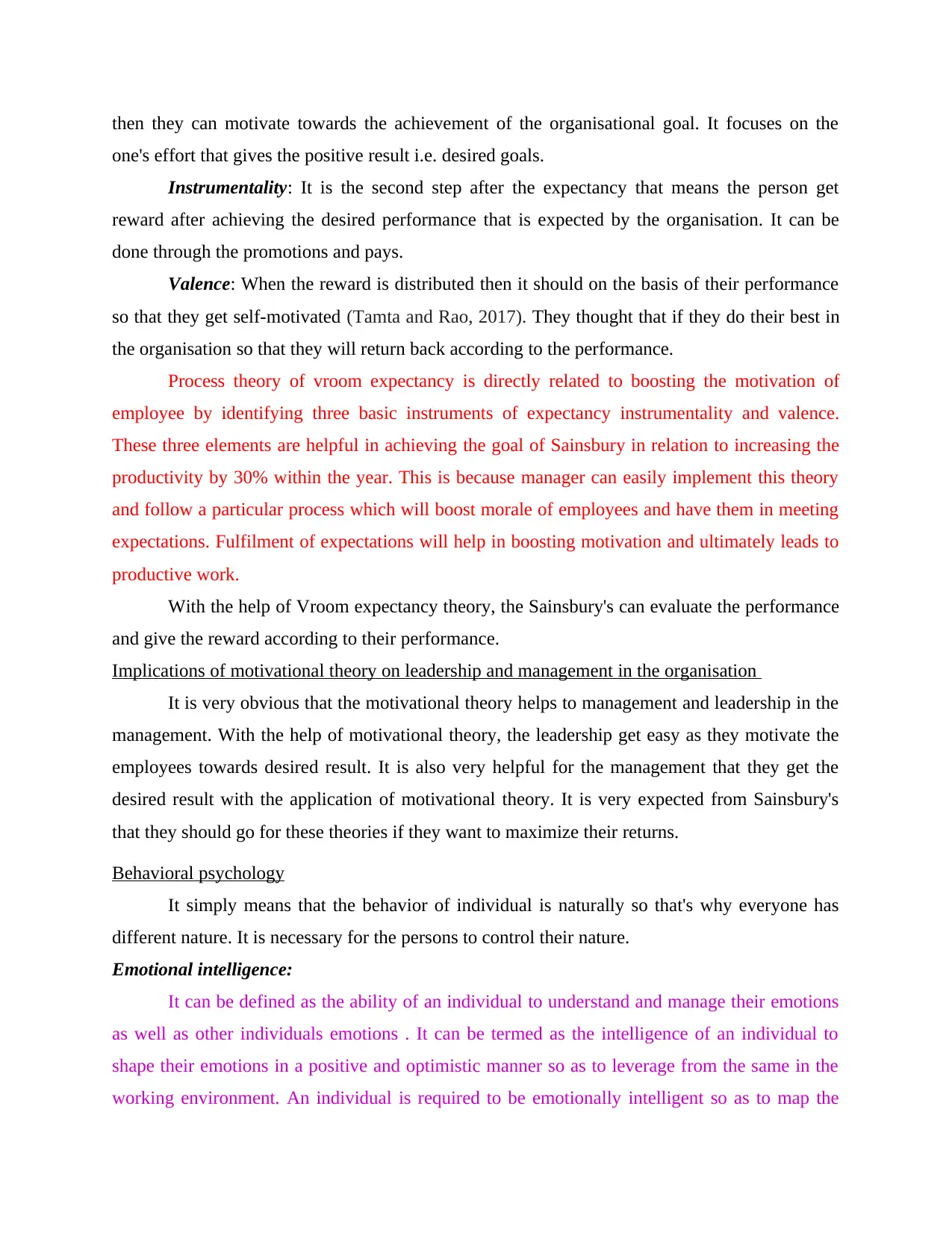
then they can motivate towards the achievement of the organisational goal. It focuses on the
one's effort that gives the positive result i.e. desired goals.
Instrumentality: It is the second step after the expectancy that means the person get
reward after achieving the desired performance that is expected by the organisation. It can be
done through the promotions and pays.
Valence: When the reward is distributed then it should on the basis of their performance
so that they get self-motivated (Tamta and Rao, 2017). They thought that if they do their best in
the organisation so that they will return back according to the performance.
Process theory of vroom expectancy is directly related to boosting the motivation of
employee by identifying three basic instruments of expectancy instrumentality and valence.
These three elements are helpful in achieving the goal of Sainsbury in relation to increasing the
productivity by 30% within the year. This is because manager can easily implement this theory
and follow a particular process which will boost morale of employees and have them in meeting
expectations. Fulfilment of expectations will help in boosting motivation and ultimately leads to
productive work.
With the help of Vroom expectancy theory, the Sainsbury's can evaluate the performance
and give the reward according to their performance.
Implications of motivational theory on leadership and management in the organisation
It is very obvious that the motivational theory helps to management and leadership in the
management. With the help of motivational theory, the leadership get easy as they motivate the
employees towards desired result. It is also very helpful for the management that they get the
desired result with the application of motivational theory. It is very expected from Sainsbury's
that they should go for these theories if they want to maximize their returns.
Behavioral psychology
It simply means that the behavior of individual is naturally so that's why everyone has
different nature. It is necessary for the persons to control their nature.
Emotional intelligence:
It can be defined as the ability of an individual to understand and manage their emotions
as well as other individuals emotions . It can be termed as the intelligence of an individual to
shape their emotions in a positive and optimistic manner so as to leverage from the same in the
working environment. An individual is required to be emotionally intelligent so as to map the
one's effort that gives the positive result i.e. desired goals.
Instrumentality: It is the second step after the expectancy that means the person get
reward after achieving the desired performance that is expected by the organisation. It can be
done through the promotions and pays.
Valence: When the reward is distributed then it should on the basis of their performance
so that they get self-motivated (Tamta and Rao, 2017). They thought that if they do their best in
the organisation so that they will return back according to the performance.
Process theory of vroom expectancy is directly related to boosting the motivation of
employee by identifying three basic instruments of expectancy instrumentality and valence.
These three elements are helpful in achieving the goal of Sainsbury in relation to increasing the
productivity by 30% within the year. This is because manager can easily implement this theory
and follow a particular process which will boost morale of employees and have them in meeting
expectations. Fulfilment of expectations will help in boosting motivation and ultimately leads to
productive work.
With the help of Vroom expectancy theory, the Sainsbury's can evaluate the performance
and give the reward according to their performance.
Implications of motivational theory on leadership and management in the organisation
It is very obvious that the motivational theory helps to management and leadership in the
management. With the help of motivational theory, the leadership get easy as they motivate the
employees towards desired result. It is also very helpful for the management that they get the
desired result with the application of motivational theory. It is very expected from Sainsbury's
that they should go for these theories if they want to maximize their returns.
Behavioral psychology
It simply means that the behavior of individual is naturally so that's why everyone has
different nature. It is necessary for the persons to control their nature.
Emotional intelligence:
It can be defined as the ability of an individual to understand and manage their emotions
as well as other individuals emotions . It can be termed as the intelligence of an individual to
shape their emotions in a positive and optimistic manner so as to leverage from the same in the
working environment. An individual is required to be emotionally intelligent so as to map the
Paraphrase This Document
Need a fresh take? Get an instant paraphrase of this document with our AI Paraphraser
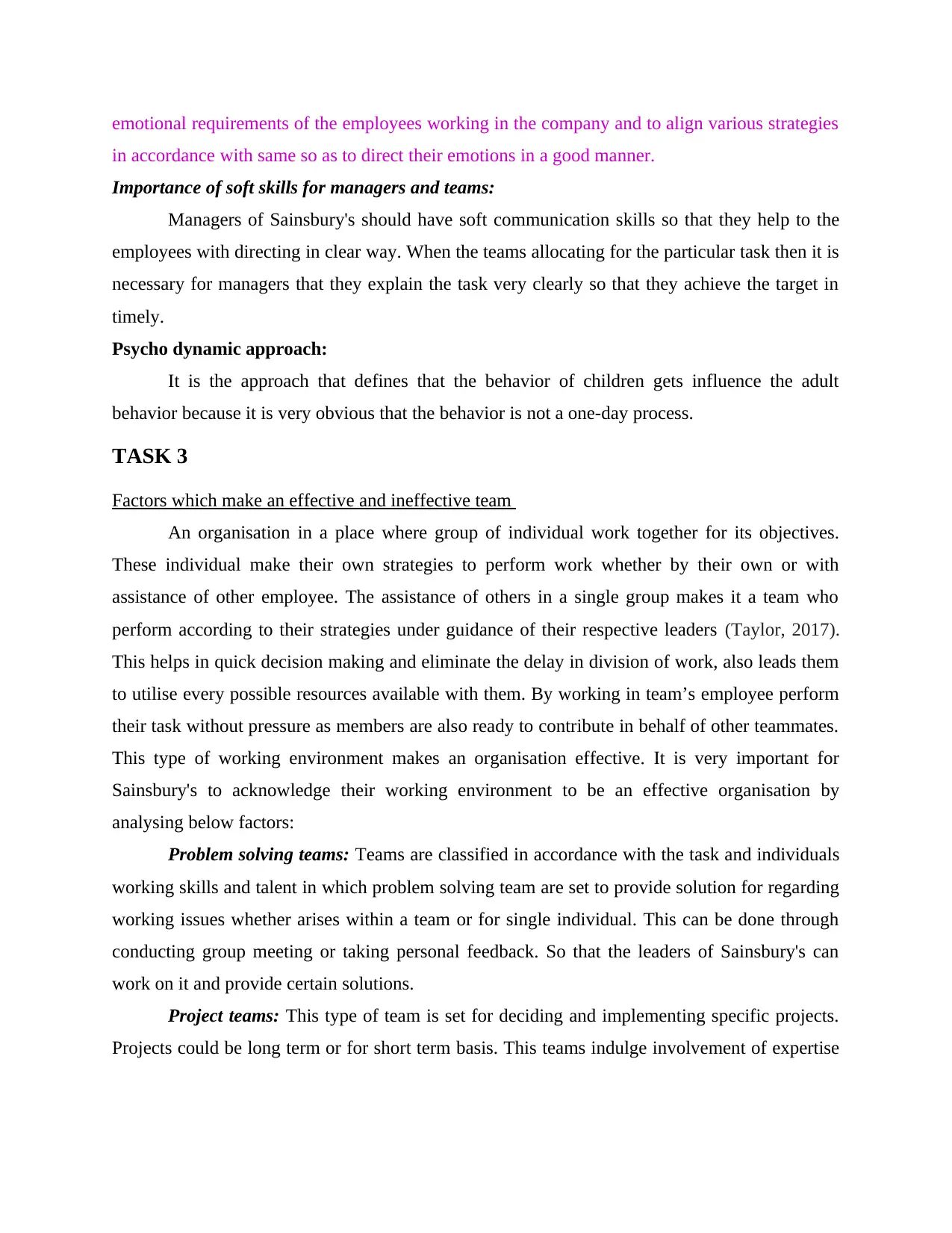
emotional requirements of the employees working in the company and to align various strategies
in accordance with same so as to direct their emotions in a good manner.
Importance of soft skills for managers and teams:
Managers of Sainsbury's should have soft communication skills so that they help to the
employees with directing in clear way. When the teams allocating for the particular task then it is
necessary for managers that they explain the task very clearly so that they achieve the target in
timely.
Psycho dynamic approach:
It is the approach that defines that the behavior of children gets influence the adult
behavior because it is very obvious that the behavior is not a one-day process.
TASK 3
Factors which make an effective and ineffective team
An organisation in a place where group of individual work together for its objectives.
These individual make their own strategies to perform work whether by their own or with
assistance of other employee. The assistance of others in a single group makes it a team who
perform according to their strategies under guidance of their respective leaders (Taylor, 2017).
This helps in quick decision making and eliminate the delay in division of work, also leads them
to utilise every possible resources available with them. By working in team’s employee perform
their task without pressure as members are also ready to contribute in behalf of other teammates.
This type of working environment makes an organisation effective. It is very important for
Sainsbury's to acknowledge their working environment to be an effective organisation by
analysing below factors:
Problem solving teams: Teams are classified in accordance with the task and individuals
working skills and talent in which problem solving team are set to provide solution for regarding
working issues whether arises within a team or for single individual. This can be done through
conducting group meeting or taking personal feedback. So that the leaders of Sainsbury's can
work on it and provide certain solutions.
Project teams: This type of team is set for deciding and implementing specific projects.
Projects could be long term or for short term basis. This teams indulge involvement of expertise
in accordance with same so as to direct their emotions in a good manner.
Importance of soft skills for managers and teams:
Managers of Sainsbury's should have soft communication skills so that they help to the
employees with directing in clear way. When the teams allocating for the particular task then it is
necessary for managers that they explain the task very clearly so that they achieve the target in
timely.
Psycho dynamic approach:
It is the approach that defines that the behavior of children gets influence the adult
behavior because it is very obvious that the behavior is not a one-day process.
TASK 3
Factors which make an effective and ineffective team
An organisation in a place where group of individual work together for its objectives.
These individual make their own strategies to perform work whether by their own or with
assistance of other employee. The assistance of others in a single group makes it a team who
perform according to their strategies under guidance of their respective leaders (Taylor, 2017).
This helps in quick decision making and eliminate the delay in division of work, also leads them
to utilise every possible resources available with them. By working in team’s employee perform
their task without pressure as members are also ready to contribute in behalf of other teammates.
This type of working environment makes an organisation effective. It is very important for
Sainsbury's to acknowledge their working environment to be an effective organisation by
analysing below factors:
Problem solving teams: Teams are classified in accordance with the task and individuals
working skills and talent in which problem solving team are set to provide solution for regarding
working issues whether arises within a team or for single individual. This can be done through
conducting group meeting or taking personal feedback. So that the leaders of Sainsbury's can
work on it and provide certain solutions.
Project teams: This type of team is set for deciding and implementing specific projects.
Projects could be long term or for short term basis. This teams indulge involvement of expertise

in every field to set plans and goals for specific project and try to make it efficient in every
possible way along with the planning of required workforce to execute their project plans.
Functional teams: The workers involve in this team are set to perform all organisational
activities according to their roles and responsibilities, a manager of the Sainsbury's make them
perform various tasks and work all together in order to achieve standard targets.
Virtual teams: Individuals working in this team are connected through technically or
socially and implement their tasks on virtual platform. The task organised to this team are mainly
of making strategies and policies or opinions in context of any changes.
These are the factors which can be used by Organisation in order to perform its function
and formulate effective teams. These things are used for sensory in achieving its objectives and
managing different function according to the needs and requirement of different task.
Tuckman’s model of team development
Teams are group of individuals working for a set goals for an organisation. It’s not
necessary that every individual perform always well, at some point of time they want to fulfil
their own desires to achieve more in terms of job designation or benefits and compensation
(Rickards and Moger, 2000). The managers of Sainsbury's must ensure their employees welfare by
encouraging or train them for their own development (Toppazzini and Wiener, 2017). This can
be done by giving them different roles and tasks to perform, after that comparison of
performance from past leads to result in their development wheatear it could be negative or
positive. In case of negative result mangers would know about their weak areas to work on.
Tuckman's models are effective ways for team development which are described below:
Forming: This is the primary step in which members are depend on the decisions of
leaders, before performing any task permission must be granted by set leaders. As the model
states, forming of task, job roles, working capacity and effectiveness are the key areas to work on
under supervision of leaders. This power encourages other workers to have leadership qualities:
within them therefore, motivates them to work hard and develop them for high performance.
Storming: In this step, team members are focused to build relations with their teammates
which makes a team supportive and effective at a same time when everyone working for the
same objective.
Norming: In this step, decisions regarding performing and dividing of tasks are
dependent on mutual concerns of all the members by way of discussion or group meetings. In
possible way along with the planning of required workforce to execute their project plans.
Functional teams: The workers involve in this team are set to perform all organisational
activities according to their roles and responsibilities, a manager of the Sainsbury's make them
perform various tasks and work all together in order to achieve standard targets.
Virtual teams: Individuals working in this team are connected through technically or
socially and implement their tasks on virtual platform. The task organised to this team are mainly
of making strategies and policies or opinions in context of any changes.
These are the factors which can be used by Organisation in order to perform its function
and formulate effective teams. These things are used for sensory in achieving its objectives and
managing different function according to the needs and requirement of different task.
Tuckman’s model of team development
Teams are group of individuals working for a set goals for an organisation. It’s not
necessary that every individual perform always well, at some point of time they want to fulfil
their own desires to achieve more in terms of job designation or benefits and compensation
(Rickards and Moger, 2000). The managers of Sainsbury's must ensure their employees welfare by
encouraging or train them for their own development (Toppazzini and Wiener, 2017). This can
be done by giving them different roles and tasks to perform, after that comparison of
performance from past leads to result in their development wheatear it could be negative or
positive. In case of negative result mangers would know about their weak areas to work on.
Tuckman's models are effective ways for team development which are described below:
Forming: This is the primary step in which members are depend on the decisions of
leaders, before performing any task permission must be granted by set leaders. As the model
states, forming of task, job roles, working capacity and effectiveness are the key areas to work on
under supervision of leaders. This power encourages other workers to have leadership qualities:
within them therefore, motivates them to work hard and develop them for high performance.
Storming: In this step, team members are focused to build relations with their teammates
which makes a team supportive and effective at a same time when everyone working for the
same objective.
Norming: In this step, decisions regarding performing and dividing of tasks are
dependent on mutual concerns of all the members by way of discussion or group meetings. In
⊘ This is a preview!⊘
Do you want full access?
Subscribe today to unlock all pages.

Trusted by 1+ million students worldwide
1 out of 18
Related Documents
Your All-in-One AI-Powered Toolkit for Academic Success.
+13062052269
info@desklib.com
Available 24*7 on WhatsApp / Email
![[object Object]](/_next/static/media/star-bottom.7253800d.svg)
Unlock your academic potential
Copyright © 2020–2025 A2Z Services. All Rights Reserved. Developed and managed by ZUCOL.




